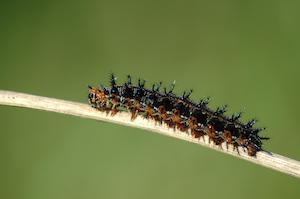
Common Buckeye Caterpillar
(Photo: Todd Schneider/GADNR)- Gardening for Butterflies
- Caterpillar Food Plants
- Conservation
- Resources
- Georgia Butterflies Brochure
- Butterflies of Georgia Checklist
- Backyard Butterflies Brochure
In North America north of Mexico there are approximately 750 species of butterflies. Georgia alone boasts over 160 species. Almost any yard in Georgia can successfully lure 30 or so species in a year. In order to create a garden for butterflies, one needs to understand the life history of the insect.
The Life Cycle of a Butterfly
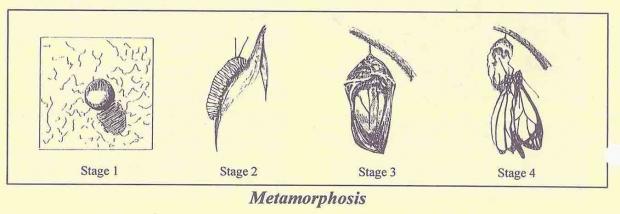
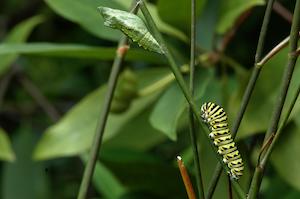
(Photo: Todd Schneider/GADNR)
Since butterflies do not tend their offspring, the egg is a particularly valuable stage in the butterfly's life cycle. The female butterfly deposits the eggs, often in large numbers, on or near a suitable host plant. These small and compact eggs come in many shapes (round, oblong, barrel, etc.) and colors (yellow, green, brown, etc.), according to the species of butterfly (Stage 1). After a few days, generally four to 10, the eggs hatch. However, eggs produced by the adults in late summer or fall may overwinter until bud break the following spring, allowing the larvae to feed on new, tender foliage upon hatching.
After hatching, a tiny caterpillar (larva) emerges and, depending upon the species, its first meal may be either its eggshell or its host plant. Upon reaching the appropriate host plant, the caterpillar begins eating voraciously (Stage 2). The caterpillars of most eastern butterflies feed at night and take refuge within folded leaves or webs by day. As the caterpillar increases in size, it must shed its skin (molt) a number of times. Just as with the eggs, larvae of different butterfly species are distinctly colored, shaped and sized. After three to four weeks of feeding and growth, the larvae of most species of butterflies are ready to pupate or to form a chrysalis. Many of the caterpillars present in late September or October overwinter in the larval stage. Most of these hibernate when half grown, but some actually spend the winter as newly hatched caterpillars waiting for spring bud break to begin eating. Depending upon the species, the larvae may take shelter under leaves, in hollow stems, or under rocks or loose bark. Some larvae even overwinter inside fruits or pods.
After shedding its skin for the last time the caterpillar pupates, or forms a chrysalis, again distinctly shaped, sized and colored (Stage 3). Inside this sheathing the final stage of the metamorphosis takes place. The larval structures are broken down and the adult is formed, usually in 1 to 2 weeks. In some species, the fall larvae feed then pupate in a sheltered spot and await spring or warm weather before completing their development. The pupa (chrysalis) may be openly attached to vegetation by silk and therefore exposed all winter, or it may be concealed and thus somewhat protected in dried leaves or under bark.
The adult butterfly emerges from its chrysalis with small, damp wings. The insect is particularly vulnerable at this point. The butterfly will hang with its wings down and slowly expand them by pumping "blood" through its soft wing veins (Stage 4). Upon expansion, the wings are slowly pumped until they are dry. Most butterflies will rest for a short while, approximately one hour, before flying. Some butterflies overwinter as adults, spending periods of cold and/or wet weather roosting in hollow trees, beneath bark, on dead branches, in abandoned buildings, or in any sheltered accessible location. A careful search of likely spots during midwinter may yield a Mourning Cloak, Comma, Question Mark, Cloudless Sulphur or Little Sulphur. Hibernation may be interrupted on warm, sunny days when the butterfly emerges to fly and feed.
Gardening for Butterflies
To attract butterflies successfully you will need to provide areas suited for all stages (egg, larva, pupa and adult) of a butterfly's life.
Before planting a garden, become familiar with the butterflies you are hoping to attract. It would be an exercise in frustration to attempt attracting Hessel's Hairstreak to your garden if you are miles from a white cedar swamp, or even Great Purple Hairstreak if you are miles from trees harboring mistletoe, the only caterpillar hosts of these species.
Butterflies are cold-blooded; therefore, at rest their body temperatures are the same as the surrounding environment. As a general rule they fly when air temperatures are between 16° and 42°C (60–108°F). For this reason, situate your garden in a warm, sunny area with protection from the wind. The addition of a few stones, bricks or bare patches of ground will act as solar collectors, providing basking spots for butterflies in early morning or during cool weather, enabling them to raise their body temperatures more quickly.
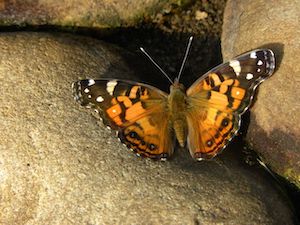
Plan, then plant the garden. Include a mix of host plants and nectar plants preferred by your local butterflies. Georgia's butterflies evolved with Georgia's plants; therefore, it is preferable to garden with native species whenever possible. Remember to purchase nursery-propagated stock or propagate your own. Do not dig plants from the wild. Whether you use native or exotic plants there are a few principles to keep in mind. Plan for continual bloom, at least early spring through late fall. Some butterflies are seasonal in their occurrence while others occur throughout the flowering season. Flowers in winter may lure the butterflies who emerge from hibernation on warm days. When choosing nectar plants, remember that single flowers tend to produce more nectar and are more accessible to the butterflies than are double ones. Don't be a skinflint! Since butterflies are attracted by expanses of color, plant in groups or clumps rather than a single plant here or there. Don't forget to incorporate host plants into the garden, many of which are ornamental and good nectar plants as well.
Don't be compulsively neat! Butterflies, especially their eggs and larvae, are eagerly sought by predators such as birds, lizards, spiders, parasitic flies and wasps. Let these hunters search rather than offering your butterflies to them on a groomed, manicured platter. Grasses not only afford shelter to all phases of a butterfly's life but are the larval host plants for quite a few. Incorporate some native grasses into your planting and refrain from mowing. Don't be so quick to remove leaves, plant debris and stubble, which could be sheltering a future butterfly.
The gardener who plants fruitless ornamentals to avoid the "mess" of falling and rotting fruit deprives him- or herself of visits from some of our loveliest butterflies. A glance at the Butterflies of Georgia Gardens and Their Food Sources chart reveals several butterflies who feed on rotting fruit. If you can't or don't wish to plant for these butterflies, then you could create a feeding station with buckets of overripe fruit. Some report great luck with a fermented mixture of rotten fruit, stale beer, molasses or sugar and yeast served on a plate or smeared on tree trunks. If this is too offensive for you or the neighbors, a few judiciously placed banana peels may lure some of these "ooze" feeders.
Providing a shallow pool with muddy edges may invite a "puddle-party" to your garden. Some male butterflies, especially Tiger Swallowtails and Cloudless Sulphurs, seem irresistibly drawn to the minerals and moisture in mud surrounding these pools.
The butterfly garden is no place for pesticides and herbicides. Although some caterpillars feed on garden plants such as cabbage, broccoli, turnips and mustard (for instance the Cabbage Butterfly), or parsley, fennel, dill and carrots (for instance the Black Swallowtail), avoid the temptation to spray, for you may kill other butterfly species that are attracted to your flowering garden plants. Always plant a few extra vegetables for the caterpillars and you later will be rewarded with beautiful butterflies.
Caterpillar Food Plants
While adult butterflies often obtain nectar from a wide variety of plants, most rely on very few plants to provide food for their caterpillars. One of the easiest ways to increase both the number and variety of butterflies is to incorporate larval food plants into the landscape surrounding your home. Enjoy planting these important caterpillar food plants and watch the beautiful variety of butterflies come to your backyard through the spring and summer seasons.
(Photo: Todd Schneider/GADNR)
Caterpillar Food Plant
Butterfly
Silvery Checkerspot
Gemmed Satyr
Whirlabout
Sachem
Southern Skipperling
Common Roadside Skipper
Zarucco Duskywing
Great Southern White
Southern Pearly-eye
Creole Pearly-eye
(i.e. Sicklepod, Partridge Pea)
Cloudless Sulphur
Little Yellow
Eastern Tiger Swallowtail
Striped Hairstreak
Red-spotted Purple
Coral Hairstreak
Mourning Cloak
Red-spotted Purple
Eastern Comma
Mourning Cloak
Question Mark
Hackberry Emperor
Tawny Emperor
Mourning Cloak
Common Checkered Skipper
Painted Lady
Queen
Eastern Comma
Question Mark
Horace's Duskywing
Juvenal's Duskywing
Southern Hairstreak
Zebra
Variegated Fritillary
Baltimore Checkerspot
Spicebush Swallowtail
Diana Fritillary
Orange Sulphur
Viceroy
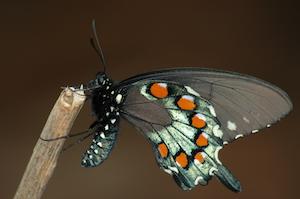
(Photo: Todd Schneider/GADNR)
Conservation
Butterflies are dependent upon plants to provide nourishment for their young and nectar from flowers for their adult food. Butterfly gardening may bring some of these beautiful insects up close for your enjoyment, but habitat preservation is the only solution to butterfly conservation. To date, the only known extinctions of butterflies (for example, the Xerces Blue in California) have resulted from habitat destruction.
Residential and commercial development, wetland alterations, reservoir construction and some logging and farming practices can be harmful to butterfly populations. Even the exclusion of fires from fire-dependent plant communities allows the overgrowth of trees and shrubs to smother some butterfly habitats. The enormous numbers of some insects and the frequency of their reproduction allow them to recover from a short-term decline in numbers. But many butterflies are dependent upon a few specific plants for their survival. Also, some of these plants are dependent upon unique habitats such as mountain meadows, hardwood swamps, coastal dunes and salt marshes for their survival. If these habitats are destroyed, the butterflies associated with them are seldom able to relocate.
The reduction in butterfly numbers and species is a good indication that there is loss in plant communities. Because of this intimate involvement with plants, butterflies are extremely important in reflecting loss of habitat. Habitat conservation is needed to preserve Georgia's rich butterfly heritage.
Resources
- Monarchs Across Georgia (an initiative of the Environmental Education Alliance)
- My Monarch Butterfly Coloring Book
- Monarch Butterflies & Georgia Gardeners Brochure (milkweed species recommendations)
- Recommended Native Plant Nurseries
- Georgia Pollinator Partnership
- Great Georgia Pollinator Census




















